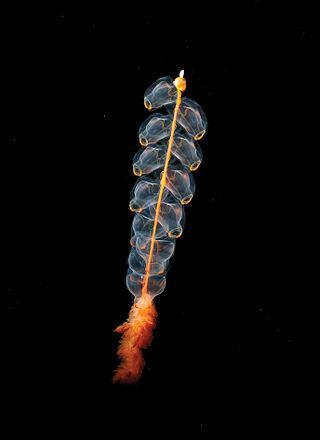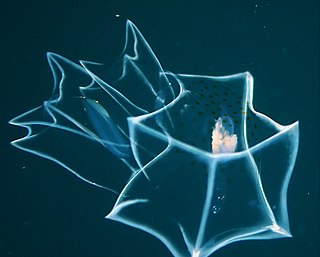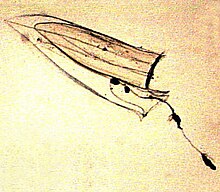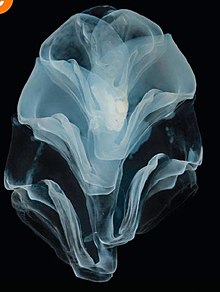
Cnidaria is a phylum under kingdom Animalia containing over 11,000 species of aquatic animals found both in fresh water and marine environments, including jellyfish, hydroids, sea anemones, corals and some of the smallest marine parasites. Their distinguishing features are a decentralized nervous system distributed throughout a gelatinous body and the presence of cnidocytes or cnidoblasts, specialized cells with ejectable flagella used mainly for envenomation and capturing prey. Their bodies consist of mesoglea, a non-living, jelly-like substance, sandwiched between two layers of epithelium that are mostly one cell thick. Cnidarians are also some of the only animals that can reproduce both sexually and asexually.

The Portuguese man o' war, also known as the man-of-war or bluebottle, is a marine hydrozoan found in the Atlantic Ocean and the Indian Ocean. It is considered to be the same species as the Pacific man o' war or bluebottle, which is found mainly in the Pacific Ocean. The Portuguese man o' war is the only species in the genus Physalia, which in turn is the only genus in the family Physaliidae.

Hydrozoa is a taxonomic class of individually very small, predatory animals, some solitary and some colonial, most of which inhabit saline water. The colonies of the colonial species can be large, and in some cases the specialized individual animals cannot survive outside the colony. A few genera within this class live in freshwater habitats. Hydrozoans are related to jellyfish and corals and belong to the phylum Cnidaria.

Siphonophorae is an order within Hydrozoa, which is a class of marine organisms within the phylum Cnidaria. According to the World Register of Marine Species, the order contains 175 species described thus far.

Praya dubia, the giant siphonophore, lives in the mesopelagic zone to bathypelagic zone at 700 m (2,300 ft) to 1,000 m (3,300 ft) below sea level. It has been found off the coasts around the world, from Iceland in the North Atlantic to Chile in the South Pacific.

Leptothecata, or thecate hydroids, are an order of hydrozoans in the phylum Cnidaria. Their closest living relatives are the athecate hydroids, which are similar enough to have always been considered closely related, and the very apomorphic Siphonophorae, which were placed outside the "Hydroida". Given that there are no firm rules for synonymy for high-ranked taxa, alternative names like Leptomedusa, Thecaphora or Thecata, with or without the ending emended to "-ae", are also often used for Leptothecata.

Marrus orthocanna is a species of pelagic siphonophore, a colonial animal composed of a complex arrangement of zooids, some of which are polyps and some medusae. Swimming independently in the mid-ocean, it lives in the Arctic and other cold, deep waters. It is a colonial creature that is born from a single egg which is fertilized. Later on, a protozoan forms that eventually grows to form more duplicating members of the colony. It belongs to the order Siphonophorae and the genus Marrus, which also includes M. antarcticus, M. claudanielis, and M. orthocannoides.

Apolemia is a genus of siphonophores. It is the only genus in the monotypic family Apolemiidae.

Porpita prunella is a marine species of hydrozoan organisms within the family Porpitidae. It consists of colonies of zooids. Very little is known about this species, as there have been no confirmed sightings since its discovery in 1801 and naming by Haeckel in 1888. Being in the chondrophore group, it is likely that its behaviour is similar to the other species of the genera in the family. However there are also serious doubts as to its very existence as a separate species and may in fact be a synonym for Porpita porpita instead.

Muggiaea atlantica is a species of small hydrozoan, a siphonophore in the family Diphyidae. It is a cosmopolitan species occurring in inshore waters of many of the world's oceans, and it has colonised new areas such as the North Sea and the Adriatic Sea. It is subject to large population swings, and has been held responsible for the death of farmed salmon in Norway. The species was first described by J.T. Cunningham in 1892 from a specimen obtained at Plymouth, England.
Muggiaea kochii is a species of small hydrozoan, a siphonophore in the family Diphyidae.
In biology, Gonozooids are any of the reproductive individuals of Tunicates, Bryozoan, or Hydrozoan colonies that produce gametes. Gonozooids may play a role in labour division or in alternation of generations. A gonozooid typically has hardly any other function than reproduction, amounting to little more than a motile gonad.

Bathyphysa conifera, sometimes called the flying spaghetti monster, is a bathypelagic species of siphonophore in the family Rhizophysidae. It is found in the northern Atlantic Ocean and off the coast of Southwestern Africa and California.

Physonectae is a suborder of siphonophores. In Japanese it is called 胞泳.

Bassia is a monotypic siphonophore genus in the family Abylidae. The genus contains the single species Bassia bassensis.
Nanomia bijuga, first described by Stefano Delle Chiaje in 1844 and originally named Physsophora bijuga, is a species of mesopelagic siphonophore in the family Agalmatidae As with all members of the siphonophorae order, it is a colonial organism composed of individual zooids. N. bijuga has a fairly broad distribution, and has been observed in the coastal waters off of North America and Europe. The species has been found to occupy both epipelagic and mesopelagic depths. They utilize specialized swimming zooids for both propulsion and escape behaviors. Similar to other siphonophores, Nanomia bijuga employ stinging tentacles for hunting and defense. They primarily feed on small crustaceans, especially krill.

Abylopsis tetragona is a species of siphonophore in the family Abylidae.

Zancleidae is a family of cnidarians belonging to the order Anthoathecata.
Lensia is a genus of hydrozoans belonging to the order Siphonoporae and the family Diphyidae. This genus is colonial and consists of many different types of highly specialized zooids. The genus Lensia was first established in 1932 by Dr. Arthur Knyvett Totton, who would also describe and add another 11 species during his career. As of March 2023, the genus consists of only 26 described and accepted species and an additional seven uncertain species, according to the World Register of Marine Species.
Tima nigroannulata, commonly known as the elegant jellyfish, is a recently discovered colonial hydrozoa found on the Pacific coast of Japan.

















